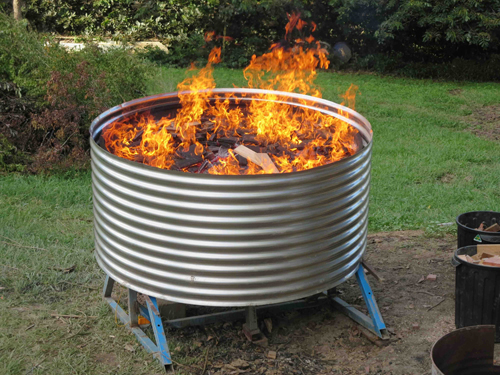Kon-Tiki Kiln: Difference between revisions
mNo edit summary |
mNo edit summary |
||
| Line 5: | Line 5: | ||
Ithaka Institut writes: ''While most of the [[biochar]] produced during the last 5000 years was produced with open fire, modern pyrolysis suppresses the fire. The separation of the carbonisation and the flaming of the pyrolysis gases make pyrolysis technology prone to failure and expensive which is one of the reasons why the biochar technology did not have yet it's breakthrough. The Kon-Tiki flame curtain kiln re-connects biochar making to the ancient wisdom and craft of fire making and combines it with smart design based on modern thermodynamics to produce high quality char with low emissions.'' | Ithaka Institut writes: ''While most of the [[biochar]] produced during the last 5000 years was produced with open fire, modern pyrolysis suppresses the fire. The separation of the carbonisation and the flaming of the pyrolysis gases make pyrolysis technology prone to failure and expensive which is one of the reasons why the biochar technology did not have yet it's breakthrough. The Kon-Tiki flame curtain kiln re-connects biochar making to the ancient wisdom and craft of fire making and combines it with smart design based on modern thermodynamics to produce high quality char with low emissions.'' | ||
==Assessment== | |||
My (Rasmus) opinion: these types of open-burn kilns appear to have some advantages over those "barrel-in-a-barrel" retorts that were advocated in the past. This kiln does away with the internal metal barrier which is costly, corrodes easily and is labor-intensive to produce. The Kon-Tiki kiln can be tilted after the burn, allowing the [[biochar]] to be dumped easily for further use. The char produced with open burn kilns may be of higher quality, because volatiles and tars can evaporate more easily (a recent [http://journals.plos.org/plosone/article?id=10.1371/journal.pone.0154617 paper] provides supporting evidence for this). | My (Rasmus) opinion: these types of open-burn kilns appear to have some advantages over those "barrel-in-a-barrel" retorts that were advocated in the past. This kiln does away with the internal metal barrier which is costly, corrodes easily and is labor-intensive to produce. The Kon-Tiki kiln can be tilted after the burn, allowing the [[biochar]] to be dumped easily for further use. The char produced with open burn kilns may be of higher quality, because volatiles and tars can evaporate more easily (a recent [http://journals.plos.org/plosone/article?id=10.1371/journal.pone.0154617 paper] provides supporting evidence for this). | ||
Revision as of 10:50, 20 May 2016
Excellent open source pyrolysis kiln from Switzerland for biochar production with a very clean burn. Some implements are already available and everything is open source.
Ithaka Institut writes: While most of the biochar produced during the last 5000 years was produced with open fire, modern pyrolysis suppresses the fire. The separation of the carbonisation and the flaming of the pyrolysis gases make pyrolysis technology prone to failure and expensive which is one of the reasons why the biochar technology did not have yet it's breakthrough. The Kon-Tiki flame curtain kiln re-connects biochar making to the ancient wisdom and craft of fire making and combines it with smart design based on modern thermodynamics to produce high quality char with low emissions.
Assessment
My (Rasmus) opinion: these types of open-burn kilns appear to have some advantages over those "barrel-in-a-barrel" retorts that were advocated in the past. This kiln does away with the internal metal barrier which is costly, corrodes easily and is labor-intensive to produce. The Kon-Tiki kiln can be tilted after the burn, allowing the biochar to be dumped easily for further use. The char produced with open burn kilns may be of higher quality, because volatiles and tars can evaporate more easily (a recent paper provides supporting evidence for this).
Video
Links
- "Kon-Tiki - the democratization of biochar production" (The Biochar Jourrnal) (read this! - internal copy here)
- More videos from Ithaka Institut
- Ithaka Inst.: "Download the presentation of the Kon-Tiki technology" (.pdf)
- "Charmaking in the Himalayas" (The Biochar Journal) - has picture of full-scale “flat pack” 1000 liter Kon-Tiki
- Design drawings: "Biochar Production in Kon-Tiki Australia"
- Paper in PLOS One:"Emissions and Char Quality of Flame-Curtain "Kon Tiki" Kilns for Farmer-Scale Charcoal/Biochar Production"
